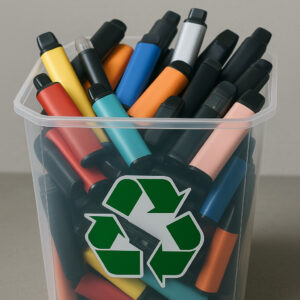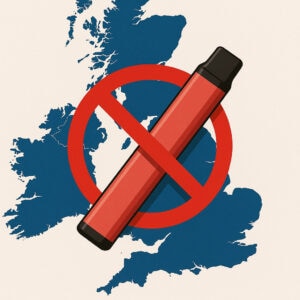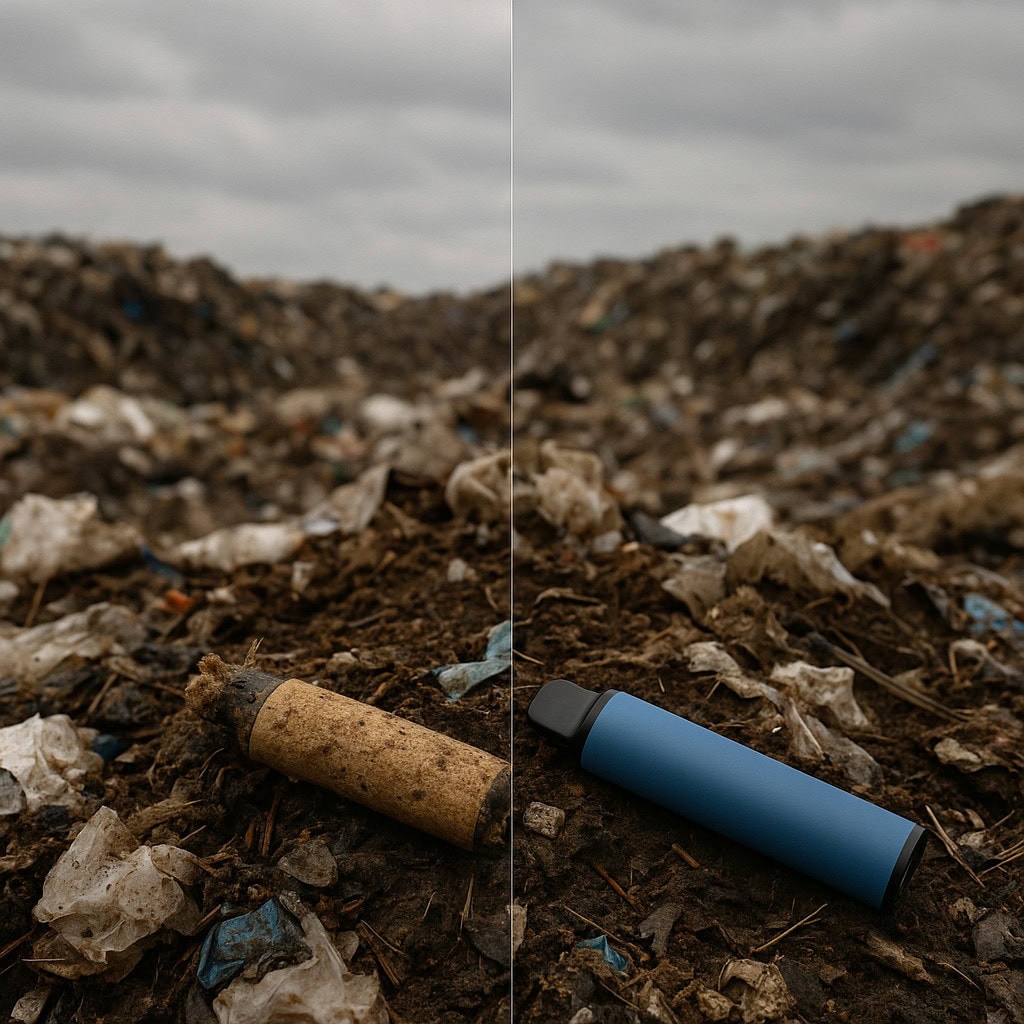We want clouds, not landfills. The era of Eco-Vaping has begun & countries are becoming aware of the dangerous waste that vapes produce. This will be no easy task for any company or country to deal with & just how far are we to cracking the disposable vs decomposable vaping code?
Are decomposable vapes possible?

well, the reality and short answer of it is “no”. We cannot yet create a fully decomposable vape, unless there are some secret alien files out there, we don’t know about. Batteries and circuitry are the main culprits here, lithium does not look good in a landfill.
Lithium-ion batteries just don’t degrade, maybe 100, 500 or 1000 years, we just don’t know. So, this problem is permanent. So, what is the solution:
Biodegradable shells: Types of special designed paper, plant or cardboard shells can do the trick to replace plastic casings. This resolves one issue.
Designed for disassembly: The trick here is to make the vapes materials re-usable or recyclable in a safe manner. Less fires caused & decreased hazmat issues. This means people have to be trusted to put them into specific recycle boxes (provided by the stores that sell them).
Water based e-liquids & more compact devices: Less waste & less chemicals.
Vape companies already there

- CCELL Eco Star (cannabis oil AIO): PLA biodegradable housing + removable Li-ion battery for separate recycling. It’s not “throw it in the compost,” but it’s a clear design-for-recycling step.
- Aquios / Innokin “Aquios Bar / Innobar/ Lota”: Paper-based body (up to 95% recyclable), 30% water e-liquid; several SKUs built around this platform.
- ANDS “SLIX”: 100% recyclable cardboard shell + biodegradable silicone mouthpiece/tail; an early “eco-disposable” approach.
How much waste is vaping creating already?

The US snapshot (2025): Around about 178.7 million disposables sold/year → so approximately 5.7 devices tossed per second. The stats are astounding (not in the good way), so this equals to around 30 tons of lithium batteries being discarded this year and around 500 000 disposables thrown away daily. Beach clean ups have seen a 150% increase in vapes on the shores this year as well.
UK stat used by policymakers: Govt cited around 5 million disposables binned weekly. So about 8 disposables thrown away every second. This was of course during pre-ban on the one use vapes. This caused fire hazards in the landfills, trucks and communal bins.
The rest of the world: The two countries have the more accurate readings of this waste compared to others. Imagine what the rest of the world is like, seeing the stats of only those two countries, the amount of nonbiodegradable & dangerous chemicals being incorrectly disposed of is for certain an immense measurement.
What countries are banning (mainly) disposable vapes and why?

There are a few main reasons why. Youth uptake being a huge issue everywhere, litter and e-waste being a big one as people do not respect others and their surroundings, hazardous fires can easily be caused inside a bin mixed with loads of flammable trash and lithium.
Belgium
Belgium kicked things off in Europe, banning disposables from the 1st of January 2025. Their reasoning? Too much plastic waste and too many teens puffing neon-colored sticks.
United Kingdom
From the 1st of June 2025, the UK goes smoke-free on single-use vapes. Shops can’t just dump leftover stock either, they’re legally bound to recycle it. Big win for bins and recycling plants.
France
France pulled the trigger in February 2025, saying “au revoir” to throwaway vapes. Their focus: protecting young people and saving the sea of discarded plastic tubes.
New Zealand
The Kiwis banned sales, supply, and manufacture of disposables from 17 June 2025. They’re blending youth protection with their already strict smoke-free laws, making NZ a world leader in vape regulation.
Australia
Australia never played nice with disposables. Imports were blocked from January 2024, and only pharmacy-sold therapeutic vapes made the cut from late 2024. Through 2025 the rules keep tightening — youth access is the main bullseye.
Ireland
Ireland is teeing up its own nationwide ban, while Northern Ireland automatically follows the UK’s June 2025 restrictions. It’s only a matter of time before the Republic officially flicks the switch.
South Africa
Here at home, the new Tobacco Products & Electronic Delivery Systems Control Bill is crawling through parliament. No outright disposable ban yet, but the direction is clear: more restrictions, less plastic clutter, and tighter rules for sellers, in the near or far future.
What should be done with expired/broken vapes?

The responsible thing to do with vapes is to dispose of them properly, the store you purchased them from should have their own recyclable bin that is dealt with correctly. Throwing away your’ vape in the bin means risk of fire (lithium + vape fluid) and contaminated waste.
Stores have a responsibility to send their broken vapes back to the supplier which has to recycle or dispose of the devices in a legal manner.
Disposable vs Devices (waste reality check)

This is where you can help, purchasing a disposable vape might be easy and sometimes more affordable. Yet you are creating a larger carbon footprint for yourself and others. Devices last longer, they often work better and can even be more affordable in the long run.
There is a good chance that vaping could be banned all together from all the waste, which is produced by disposables. Jump onto the device band wagon and save the earth & convince your friends, set an example.
Conclusion
Disposable vapes might be convenient, yet the world is quickly waking up to their ugly side, mountains of waste, fire-hazard batteries, and streets littered with plastic tubes.
The real takeaway? Vaping doesn’t have to be disposable. Refillable devices and decomposable designs are pointing the way forward. If we want clouds without the landfill, the future is simple: reuse, recycle, and rethink what’s in your pocket.


